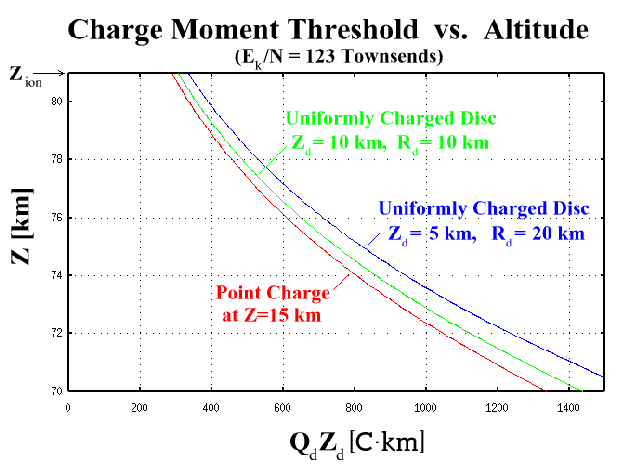The earliest estimate of the charge moment required to reach a
critical field, ![]() , at high altitudes was made by
Wilson (1925). Wilson estimated that a charge moment of about
, at high altitudes was made by
Wilson (1925). Wilson estimated that a charge moment of about
![]() C
C![]() km would be required to reach
km would be required to reach ![]() at 60 km altitude,
and that a moment about
at 60 km altitude,
and that a moment about ![]() of this (
of this (![]() C
C![]() km)
would be required to reach
km)
would be required to reach ![]() at 80 km altitude. However, Wilson's
insightful early model didn't take a couple of factors into account.
He did not incorporate the effect of an ionosphere, which nearly
doubles the observed electric field at high altitudes (see
Figure 2.7). Wilson also estimated an air density
at 60 km which was only 64
at 80 km altitude. However, Wilson's
insightful early model didn't take a couple of factors into account.
He did not incorporate the effect of an ionosphere, which nearly
doubles the observed electric field at high altitudes (see
Figure 2.7). Wilson also estimated an air density
at 60 km which was only 64![]() of the 1976 U.S. Standard Atmosphere
(Section 2.3.1). Fortuitously, the effect of these
approximations almost cancels.
of the 1976 U.S. Standard Atmosphere
(Section 2.3.1). Fortuitously, the effect of these
approximations almost cancels.
A more recent estimate was made by Fernsler and Rowland (1996) which
incorporated the effects of a realistic ionosphere height between
![]() km altitude. They estimated that the sprite initiation
threshold would be
km altitude. They estimated that the sprite initiation
threshold would be ![]() C
C![]() km at 80 km altitude and only
km at 80 km altitude and only
![]() C
C![]() km at 85 km. They also estimated that a much larger
charge moment change of
km at 85 km. They also estimated that a much larger
charge moment change of ![]() C
C![]() km would be required to produce
conventional breakdown at lower altitude during the daytime when the
base of the ionosphere is lower (see Section 4.3).
These charge moment estimates were based on the 1976 U.S. Standard
Atmosphere and an assumption that
km would be required to produce
conventional breakdown at lower altitude during the daytime when the
base of the ionosphere is lower (see Section 4.3).
These charge moment estimates were based on the 1976 U.S. Standard
Atmosphere and an assumption that
![]() .
.
 |
The charge moment required to reach a breakdown condition of
![]() (Section 2.2.3) is
plotted in Figure 2.9 as a function of altitude. The
height of the ionosphere,
(Section 2.2.3) is
plotted in Figure 2.9 as a function of altitude. The
height of the ionosphere, ![]() , was set to 81 km
(Section 2.4.4). The moments were calculated based on
electrostatics. Thus, the reduction in the electric field due to the
relaxation time as well as the enhancement due to retardation effects
Pasko et al. (1999) are not included.
, was set to 81 km
(Section 2.4.4). The moments were calculated based on
electrostatics. Thus, the reduction in the electric field due to the
relaxation time as well as the enhancement due to retardation effects
Pasko et al. (1999) are not included.
Since the charge moment threshold depends somewhat on the source
charge configuration (Section 2.5.2), the thresholds for
different parent discharge geometries are plotted. As was discussed
previously, a point charge at ![]() km altitude represents an extreme
and unlikely example, and is plotted merely as a limiting value.
km altitude represents an extreme
and unlikely example, and is plotted merely as a limiting value.
Figure 2.6 shows that the relaxation time exceeds ![]() ms
for altitudes at and below
ms
for altitudes at and below ![]() km. For a uniformly charged disk of
radius
km. For a uniformly charged disk of
radius ![]() km and height
km and height ![]() km, the charge moment
threshold would be
km, the charge moment
threshold would be ![]() C
C![]() km for breakdown at
km for breakdown at
![]() km. If the disk's radius is increased to
km. If the disk's radius is increased to ![]() km
and the height decreased to
km
and the height decreased to ![]() km, the charge moment
threshold criteria rises to
km, the charge moment
threshold criteria rises to ![]() C
C![]() km. For breakdown
at
km. For breakdown
at ![]() km, the disk charge moment thresholds would be
km, the disk charge moment thresholds would be
![]() C
C![]() km and
km and ![]() C
C![]() km, respectively.
The initiation altitude of sprites will be determined in
Chapter 5 and will be shown to be similar to the 78 km MSL
altitude used here.
km, respectively.
The initiation altitude of sprites will be determined in
Chapter 5 and will be shown to be similar to the 78 km MSL
altitude used here.
Pasko et al. (1997a) showed that discharges with charge moments exceeding the conventional breakdown threshold in a region below the base of the ionosphere would produce diffuse luminosity due to ionization within that region. Observations of these events will be presented in Chapter 5.